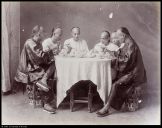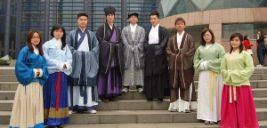Wide sleeves: good for nothing
State scholars Dahai and Kvrqan have continuously urged me to give up our Manchu garments and headgear for the sake of Chinese dress in order to conform to Chinese tradition. When I stood firm and was immune to their arguments, they told me I was not open to advice. But place yourselves in the following situation. Let us imagine all of us gathered here today wrapping ourselves up in big robes with wide sleeves. Imagine us carrying our quiver to the left and holding our bow to the right. Now what if the hero warrior Loosa Xongkoro appeared all of a sudden? Would we then be able to fight him off? Should we abandon our shooting from stance and horseback, then we might as well also start wearing big robes with wide sleeves, start eating the meat that others have slaughtered for us. Should it go down this path, how then would we be any different from those idiots? [Hong Taiji in Debtelin 02, p 43]
In 1636, Hong Taiji (1592-1643), leader of the Manchus, set the tone for the centuries to come: the Manchus were not going to allow themselves to be absorbed by the Han Chinese, the Manchus were going to stick to their own “Manchu Way”.[Keliher 2020, p 157] It was in 1644 that the last dynasty ruled by ethnic Han Chinese, the Ming dynasty (1368-1644), fell from power and was replaced by a dynasty ruled by a different ethnic group: the Manchu. The Manchus were a people from Northeastern China, showing similarities with their Mongol neighbors. They had come riding in on horseback from the Northeastern plains, and with their arrival came change.
The Manchus were a different ethnic group from the Han Chinese, and being a minority, they tried to keep themselves different from the Han Chinese. For instance, the Manchus segregated the Manchus and Han Chinese early on in Beijing, forcing the Han Chinese to live in the outer city, and the Manchus in the inner city, a policy termed “Manchu Apartheid” by scholar Frederic Wakeman.[1985, p 476]
Besides differentiating in residential areas, the Manchus also tried to establish order through adjusting people’s looks. Adopting the Manchu queue hairstyle, for instance, was mandatory for all men, whereas adopting Manchu dress was only mandatory for the scholar-official elite. However, during the course of the Qing dynasty, the Han men adopted the Manchu dress voluntarily, and many commoners thus became Manchufied.[Rhoads 2015, p 61]
It is this Manchufication that has become an important aspect in the Hanfu Movement. The Hanfu Movement in its most basic idea can be described as a contemporary social movement in China that supports the wearing of Han Chinese ethnic clothing. Central to the Hanfu Movement is the idea that this ethnic Han clothing, as worn during Han Chinese ruled dynasties, such as the Han dynasty (202BC-220AD), the Tang dynasty (618-907), and the Ming dynasty (1368-1644), has much value on its own and should be worn and appreciated by contemporary Han Chinese, just as the ethnic clothing of China’s minorities is appreciated.[Cui 2016, p 22]




